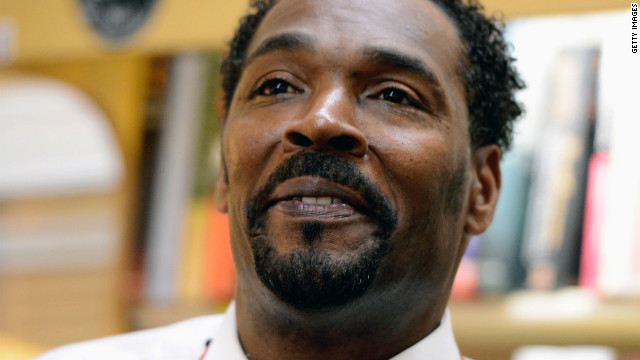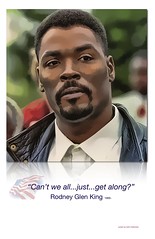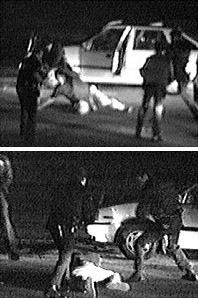| Rodney King poster (Photo credit: MarkGregory007) |
 I just heard the news that Rodney King has been found dead here in Los Angeles this morning.
This is from CNN: "Rodney King, whose beating by Los Angeles police in 1991 was caught on camera and sparked riots after the acquittal of the four officers involved, was found dead in his swimming pool Sunday, authorities and his fiancee confirmed. He was 47."
I just heard the news that Rodney King has been found dead here in Los Angeles this morning.
This is from CNN: "Rodney King, whose beating by Los Angeles police in 1991 was caught on camera and sparked riots after the acquittal of the four officers involved, was found dead in his swimming pool Sunday, authorities and his fiancee confirmed. He was 47."I am very saddened by his passing. He changed America in many, many ways. Keep him in your Prayers this day. Think about the impact this ONE person made in the lives of all of us here in Los Angeles, and around the world.
If you lived here in LA back during the "Rodney King Riots" you will truly understand the historical value of his passing today.
We really can ALL get along....
Here is more about the Life of Rodney King:
Early life
King was born in Sacramento, California to Odessa King, who had four other children. His father died at age 43. King grew up in Pasadena, California.[3]
In November 1989, King robbed a store in Monterey Park, California by threatening to hit the store owner with an iron bar and then shot him. He was convicted and sentenced to two years imprisonment.[3]
At the time of the beating, King was divorced and had three children.[3]
Incident
High speed chase
On the night of March 2, 1991, King and two passengers, Bryant Allen and Freddie Helms, were driving
 |
| LOS ANGELES, CA - APRIL 30: Rodney King arives at EsoWon bookstore to sign copies of his new book, 'The Riot Within: My Journey From Rebellion to Redemption,' on April 30, 2012 in Los Angeles, California. King is best known as the victim of a brutal police beating that took place in Los Angeles. It’s been 20 years since the Rodney King verdict that sparked infamous L.A. Riots. (Image credit: Getty Images via @daylife) |
west on Foothill Freeway (Interstate 210) in the San Fernando Valley area of Los Angeles. Prior to driving on the Foothill Freeway, the three men had spent the night watching a basketball game and drinking at a friend’s house in Los Angeles.[4] After being tested five hours after the incident, King's blood-alcohol level was found to be just under the legal limit. This meant that his blood alcohol level can be estimated at approximately 0.19 — which is almost two and a half times the legal limit in California — when he was driving.[5] At 12:30 am, Officers Tim and Melanie Singer, a husband-and-wife duo of the California Highway Patrol, spotted King’s car speeding. The officers then pursued King at high speeds, though the exact speed of the car is disputed. The initial police report stated that King had reached a speed of 117 miles per hour, but an LAPD officer later told reporters that the exact speed of King's car was closer to 90 miles per hour. [6][7] According to King’s own statements, he refused to pull the car over because he thought a DUI would violate his parole for a previous robbery conviction.[8]
King exited the freeway, and the chase continued through residential streets at speeds allegedly ranging from 55 to 80 mph.[9][10] By this point, several police cars and a helicopter had joined in the pursuit. After approximately eight miles, officers cornered King’s car. The first five LAPD officers to arrive at the scene were Stacey Koon, Laurence Powell, Timothy Wind, Theodore Briseno, and Rolando Solano.
Confrontation
Officer Tim Singer ordered King and his two passengers to exit the vehicle and lie face down on the ground. The two passengers complied and were taken into custody without incident.[4] King initially remained in the car. When he finally did emerge, he acted bizarrely: giggling; patting the ground; and waving to the police helicopter overhead.[10] King then grabbed his buttocks. Officer Melanie Singer momentarily thought he was reaching for a gun.[11] She drew her gun and pointed it at King, ordering him to lie on the ground. King complied. Singer approached King with her gun drawn, preparing to make the arrest.
At this point, Sergeant Stacey Koon intervened and ordered Officer Melanie Singer to holster her weapon. LAPD officers are taught not to approach a suspect with a drawn gun, as there is a risk of the suspect gaining control of it if they get too close.[12] Koon then ordered the four other LAPD officers at the scene — Briseno, Powell, Solano, and Wind — to subdue and handcuff King in a manner called a "swarm", a technique that involves multiple officers grabbing a suspect with empty hands. As the officers attempted to do so, King physically resisted. King rose up, tossing Officers Powell and Briseno off his back. King then struck Officer Briseno in the chest.[13] Seeing this, Koon ordered all of the officers to fall back. The officers later testified that they believed King was under the influence of the dissociative drugphencyclidine (PCP).[14] King's toxicology results tested negative for PCP.[15]
Use of the Taser
Sergeant Koon then ordered the officers to "stand clear." King was standing and was not responding to Koon's commands. Koon then fired a Taser into King's back. King groaned; momentarily fell to his knees; then stood back and yelled for almost five seconds".[16]
Beating with batons: events on the Holliday video
As George Holliday's videotape begins, King is on the ground. He rises and moves toward Powell. (Solano termed it a "lunge," and said it was in the direction of Koon.)[16] At this time, taser wires can be seen coming from King's body. As King moves forward, Officer Powell strikes King with his baton. The blow hits King's head, knocking him to the ground immediately.[17] Powell hits King several additional times with his baton. The videotape shows Briseno moving in to try and stop Powell from swinging, and Powell then backing up. (Koon reportedly yelled "that's enough.") King then rises to his knees; Powell and Wind continue to hit King with their batons while he is on the ground.[18]
Koon acknowledged that he ordered the baton blows, directing Powell and Wind to hit King with "power strokes." According to Koon, Powell and Wind used "bursts of power strokes, then backed off." The videotape shows King apparently continuing to try to get up. Koon orders the officers to "hit his joints, hit the wrists, hit his elbows, hit his knees, hit his ankles."[18] Finally, after 56 baton blows and six kicks, five or six officers swarm in and place King in both handcuffs and cordcuffs, restraining his arms and legs. King is dragged on his stomach to the side of the road to await arrival of a rescue ambulance.[18]
Unseen by those involved, George Holliday, a private citizen, caught the lengthy beating on video from his apartment near the intersection of Foothill Blvd and Osborne St. in Lake View Terrace. He contacted the police about a videotape of the incident but was dismissed. He then went to KTLA television with his videotape, which broadcast it on air in its entirety.[19] The footage became a media sensation. Portions of it were aired hundreds, if not thousands, of times around the world, and it "turned what would otherwise have been a violent, but soon forgotten, encounter between Los Angeles police and Rodney King into one of the most widely watched and discussed incidents of its kind."[20]
The video of the beating is an example of sousveillance - that is, of citizens watching police. Several copwatch organizations were subsequently organized nationally to safeguard against police abuse, including an umbrella group, October 22 Coalition to Stop Police Brutality.[21]
Post-arrest events
King was taken to Pacifica Hospital immediately after his arrest. He suffered a fractured facial bone, a broken right ankle, and numerous bruises and lacerations.[22] In a negligence claim filed with the city, King alleged he had suffered "11 skull fractures, permanent brain damage, broken [bones and teeth], kidney damage [and] emotional and physical trauma."[23] Blood and urine samples taken from King five hours after his arrest showed that he could be presumed intoxicated under California law. The tests also showed traces of marijuana (26 ng/ml), but no indication of PCP or any other illegal drug.[23] At Pacifica Hospital, where King was taken for initial treatment, nurses reported that the officers who accompanied King (including Wind) openly joked and bragged about the number of times King had been hit.[24] King sued the city over the beating, settling for $3.8 million.[25]
The officers
The Los Angeles district attorney charged officers Koon, Powell, Briseno, and Wind with use of excessive force. While Sergeant Koon did not strike King and had only used the Taser, he was the supervisory officer at the scene and was charged for "willfully permitting and failing to take action to stop the unlawful assault." The initial judge was replaced, and the new judge changed the venue, as well as the jury pool, citing contamination of the jury pool by the media coverage. The new venue was a new courthouse in Simi Valley in neighboring Ventura County. The jury consisted of Ventura County residents — tenwhite, one Latino and one Asian. The prosecutor, Terry White, was African American. On April 29, 1992, the jury acquitted three of the officers, but could not agree about one of the charges for Powell.[4]
Los Angeles Mayor Tom Bradley said, "the jury's verdict will not blind us to what we saw on that videotape. The men who beat Rodney King do not deserve to wear the uniform of the L.A.P.D."[26] PresidentGeorge H. W. Bush said, "viewed from outside the trial, it was hard to understand how the verdict could possibly square with the video. Those civil rights leaders with whom I met were stunned. And so was I and so was Barbara and so were my kids."[27]
Los Angeles riots and the aftermath
Main article: 1992 Los Angeles riots
The news of acquittal triggered the Los Angeles riots of 1992. By the time the police, the U.S. Army, Marines and National Guard restored order, the casualties included 53 deaths, 2,383 injuries, more than 7,000 fires, damages to 3,100 businesses, and nearly $1 billion in financial losses. Smaller riots occurred in other cities such as San Francisco, Las Vegas in neighboring Nevada and as far east as Atlanta,Georgia.
Federal trial of officers
After the riots, the United States Department of Justice reinstated the investigation and obtained an indictment of violations of federal civil rights against the four officers. The federal trial focused more on the evidence as to the training of officers instead of just relying on the videotape of the incident. On March 9 of the 1993 trial, King took the witness stand and described to the jury the events as he remembered them.[28] The jury found Officer Laurence Powell and Sergeant Stacey Koon guilty, and they were subsequently sentenced to 32 months in prison, while Timothy Wind and Theodore Briseño were acquitted of all charges.[4]
Later life
In 1993, King entered an alcohol rehabilitation program and was placed on probation after crashing his vehicle into a block wall in downtown Los Angeles. In July 1995, he was arrested by Alhambra police, who alleged that he hit his wife with his car, knocking her to the ground. He was sentenced to 90 days in jail after being convicted of hit and run.[29] On August 27, 2003, King was arrested again for speeding and running a red light while under the influence of alcohol. He failed to yield to police officers and slammed his vehicle into a house, breaking his pelvis.[30] On November 29, 2007, while riding home on his bicycle, King was shot in the face, arms, and back with pellets from a shotgun. He reported that it was done by a man and a woman who demanded his bicycle and shot him when he rode away.[29] Police described the wounds as looking like they came from birdshot, and said King offered few details about the suspects. In May 2008 King checked into the Pasadena Recovery Center in Pasadena, California, which was filmed as part of the second season of Celebrity Rehab with Dr. Drew, which premiered in October 2008. Dr. Drew Pinsky, who runs the facility, showed concern for King's lifestyle and said that King would die unless his addiction was treated.[31] He also appeared on Sober House, a Celebrity Rehab spin-off focusing on a sober living environment, which aired in early 2009. Both shows filmed King's quest not only to achieve sobriety, but to reestablish a relationship with his family, which had been severely damaged due to his drinking.[32]
During his time on Celebrity Rehab and Sober House, King worked not only on his addiction, but on the lingering trauma of the beating. He and Dr. Pinsky retraced his path from the night of his beating, eventually reaching the spot where it happened, the site of the Children's Museum of Los Angeles.[33]
King won[34] a celebrity boxing match against ex-Chester City (Delaware County, Pennsylvania) police officer Simon Aouad on Friday, September 11, 2009 at the Ramada Philadelphia Airport in Essington, Pennsylvania.[35]
In 2009, King and other alumni of Celebrity Rehab appeared as panel speakers to a new group of addicts at the Pasadena Recovery Center, marking 11 months of sobriety for him. His appearance was aired in the third season episode "Triggers".[36]
On September 9, 2010, it was confirmed that King was to marry Cynthia Kelley, who was a juror in the civil suit he brought against the City of Los Angeles.[37]
On March 3, 2011, King was stopped by Los Angeles police for driving erratically. He was issued a citation for driving with an expired license.[38][39][40] This arrest led to his February 2012 misdemeanor conviction for reckless driving.[41]
 |
| LOS ANGELES, CA - APRIL 30: Rodney King arrives at the EsoWon books store to sign copies of his new book, 'The Riot Within: My Journey From Rebellion to Redemption,' on April 30, 2012 in Los Angeles, California. King is best known as the victim of a brutal police beating that took place in Los Angeles. It’s been 20 years since the Rodney King verdict that sparked infamous L.A. Riots. (Image credit: Getty Images via @daylife) |
On April 12, 2012, King released a statement to the media regarding the Trayvon Martin shooting. Ki
 |
| LOS ANGELES, CA - APRIL 30: Rodney King arrives at the EsoWon books store to sign copies of his new book, 'The Riot Within: My Journey From Rebellion to Redemption,' on April 30, 2012 in Los Angeles, California. King is best known as the victim of a brutal police beating that took place in Los Angeles. It’s been 20 years since the Rodney King verdict that sparked infamous L.A. Riots. (Image credit: Getty Images via @daylife) |
ng said he was "grieving for Trayvon Martin" and stated how the scream on the audio of George Zimmerman's 911 call reminded him of his own screaming during his beating by the LAPD.[42]
 |
| LOS ANGELES, CA - APRIL 30: Rodney King arrives at the EsoWon books store to sign copies of his new book, 'The Riot Within: My Journey From Rebellion to Redemption,' on April 30, 2012 in Los Angeles, California. King is best known as the victim of a brutal police beating that took place in Los Angeles. Its been 20 years since the Rodney King verdict that sparked infamous L.A. Riots. (Image credit: Getty Images via @daylife) |
Death
On June 17, 2012, media outlets reported that King's fiancée found him dead in his swimming pool. Police in Rialto, California, received a 911 call from King's fiancee, Cynthia Kelly, about 5:25 a.m., said Capt. Randy DeAnda. Responding officers found King at the bottom of the pool, removed him and attempted to revive him. He was pronounced dead at a local hospital, DeAnda sai







No comments:
Post a Comment